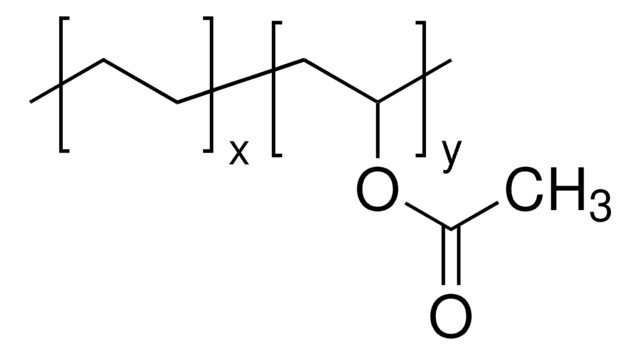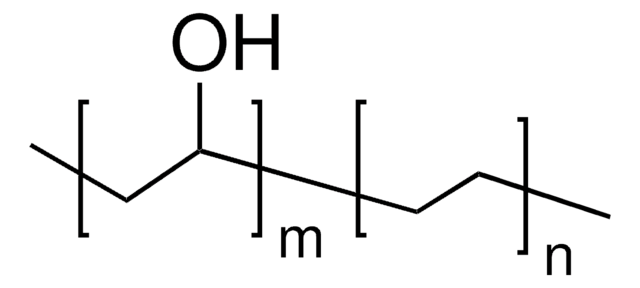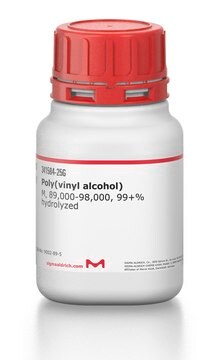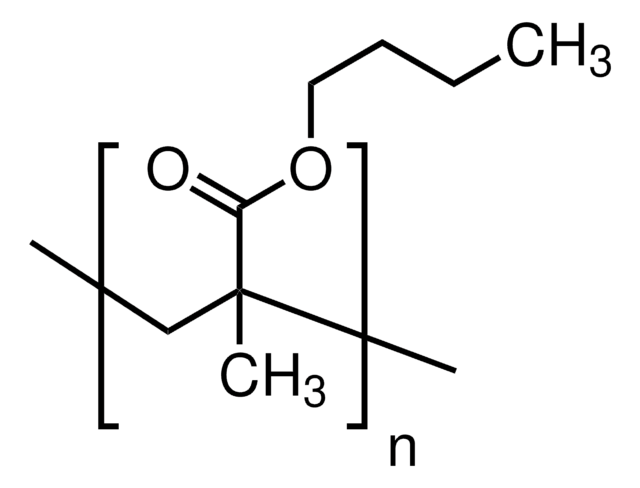340502
Poly(ethylene-co-vinyl acetate)
vinyl acetate 40 wt. %, melt index (41-63 dg/min (190°C/2.16kg)), contains 190-910 ppm inhibitor
Synonym(s):
PEVA
Sign Into View Organizational & Contract Pricing
All Photos(2)
About This Item
Linear Formula:
(CH2CH2)m[CH2CH(OCOCH3)]n
CAS Number:
MDL number:
UNSPSC Code:
12162002
PubChem Substance ID:
NACRES:
NA.23
Recommended Products
form
beads
Quality Level
autoignition temp.
500 °F
melt index
(41-63 dg/min (190°C/2.16kg))
contains
190-910 ppm inhibitor
composition
vinyl acetate, 40 wt. %
hardness
40 (Shore A-2, ASTM D 2240)
transition temp
Tg −40-−30 °C
Tm 110-120 °C
solubility
toluene, THF, and MEK: soluble
SMILES string
C=C.CC(=O)OC=C
InChI
1S/C4H6O2.C2H4/c1-2-3-4(5)6;1-2/h2H,1,3H2,(H,5,6);1-2H2
InChI key
DQXBYHZEEUGOBF-UHFFFAOYSA-N
Looking for similar products? Visit Product Comparison Guide
Related Categories
General description
Poly(ethylene-co-vinyl acetate) (PEVA) is a flame-retardant material with good mechanical and physical properties. It is majorly used as an insulating material in wire and cable industry.
Application
- Correlation between Cohesive Energy Density, Fractional Free Volume, and Gas Transport Properties: This study explores the properties of EVA materials that affect their gas permeability, important for applications like packaging and barrier materials (Kubica & Wolinska-Grabczyk, 2015).
- The Thermal and Mechanical Properties of EVA and its Crosslinked Analogues: This research investigates how crosslinking affects the thermal and mechanical properties of EVA, which could interest material scientists working with polymers (Wang & Deng, 2019).
- Investigation of morphological, rheological, and mechanical properties of cyclic olefin copolymer/EVA blend films: This study focuses on the blend properties of EVA with other polymers, providing insights useful in academia and material science (Durmus et al., 2018).
- Fabrication, characterization, and properties of EVA/magnetite nanocomposites: Relevant to material scientists, this research discusses the incorporation of magnetite nanoparticles into EVA for enhanced properties (Ramesan, 2014).
Storage Class Code
11 - Combustible Solids
WGK
nwg
Flash Point(F)
Not applicable
Flash Point(C)
Not applicable
Personal Protective Equipment
dust mask type N95 (US), Eyeshields, Gloves
Choose from one of the most recent versions:
Already Own This Product?
Find documentation for the products that you have recently purchased in the Document Library.
Preparation and flammability of a novel intumescent flame-retardant poly (ethylene-co-vinyl acetate) system
Wang D, et al.
Polymer Degradation and Stability, 93(12), 2186-2192 (2008)
Poly (ethylene-co-vinyl acetate)/clay nanocomposites: Effect of clay nature and organic modifiers on morphology, mechanical and thermal properties
Peeterbroeck S, et al.
Polymer Degradation and Stability, 90(2), 288-294 (2005)
Roberto Scaffaro et al.
Journal of food protection, 74(7), 1137-1143 (2011-07-12)
Both industry and academia have shown a growing interest in materials with antimicrobial properties suitable for food packaging applications. In this study, we prepared and characterized thin films of ethylene-co-vinyl acetate (EVA) copolymer with antimicrobial properties. The films were prepared
Kevin B Biggs et al.
Langmuir : the ACS journal of surfaces and colloids, 28(21), 8238-8243 (2012-04-27)
Drug release from and coating morphology on a CYPHER sirolimus-eluting coronary stent (SES) during in vitro elution were studied by correlated confocal Raman and atomic force microscopy (CRM and AFM, respectively). Chemical surface and subsurface maps of the SES were
Kanchana A Weerakoon et al.
Pest management science, 68(6), 906-913 (2012-01-21)
Plants emit phytochemicals as a defensive mechanism against herbivores. A small sensor switch that responds to these chemicals could be used to stop insect infestation at early stages. Polyethylene-co-vinyl acetate was chosen as the best polymer for this particular application
Our team of scientists has experience in all areas of research including Life Science, Material Science, Chemical Synthesis, Chromatography, Analytical and many others.
Contact Technical Service


![[1R-(2-endo,3-exo)]-3-Hydroxy-4,7,7-trimethylbicyclo[2.2.1]heptane-2-acetic acid 99%](/deepweb/assets/sigmaaldrich/product/structures/302/015/ab0ad101-2636-4430-bd07-e61d744f6817/640/ab0ad101-2636-4430-bd07-e61d744f6817.png)



